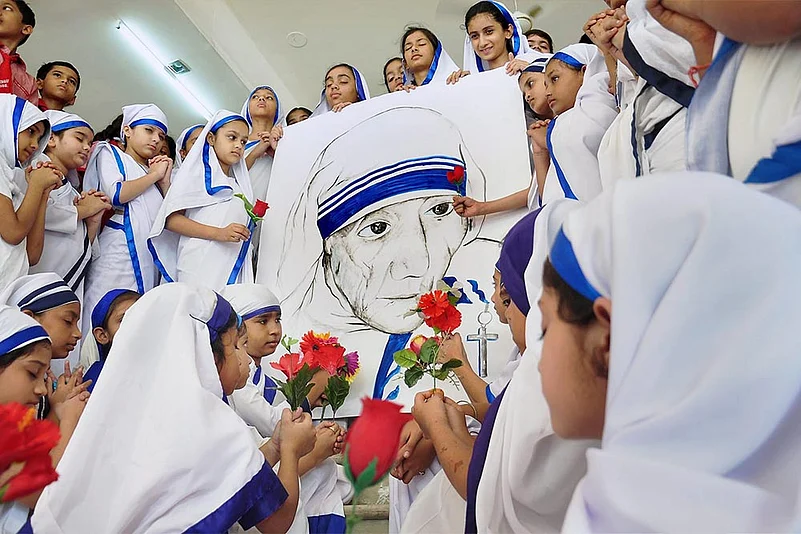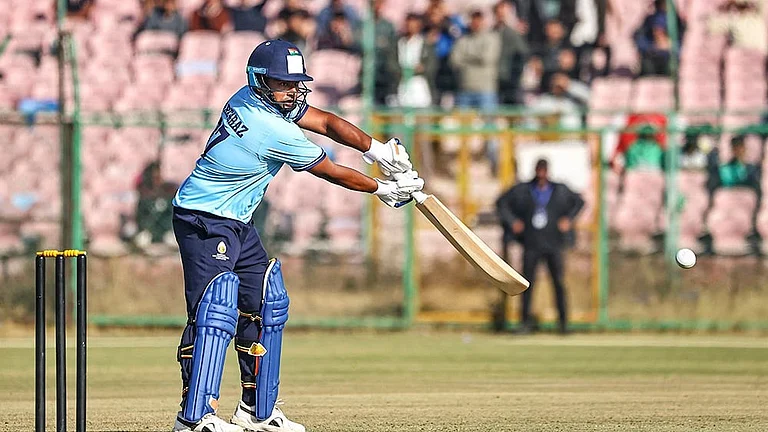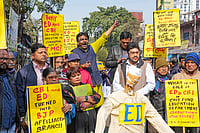Mother Teresa stretched out her hand like a beggar towards a merchant on the streets of Calcutta. “Give me something for the poor, the hungry, the sick and the lonely,” she said. He smiled diabolically and barked, “Here, take this”, and spat on her open palm. She moved her frail, quivering arm to her heart, wiped her fingers on her sari, bent low and whispered, “Thank you. This is for me. Now give me something for my children.” He was then moved to tears.
A priest of the Missionaries of Charity, who was witness to this incident—where Mother Teresa had approached a wealthy Calcutta businessman in the age-old manner of bhikshus—cannot control his own tears as he narrates it to Outlook. “She has been at the receiving end of scathing criticism for accepting money from ‘the evil’, but those who try to defile her reputation don’t understand the depth of her love and compassion. For her, no one was wicked, no one was beyond redemption. And when it came to feeding her hungry children, she didn’t care where the funds came from. She was egoless to the point that it is beyond the comprehension of our limited minds.”
Mother Teresa, the Roman Catholic nun from Skopje who arrived in Darjeeling in 1929, and made Calcutta her home—the ultimate venue of her life’s work—is to join the rarefied ranks of ‘saints’ in a formal ceremony at the Vatican on September 4. ‘Sainthood’ is a somewhat fuzzy territory—from the very many who were venerated as such in their lifetime, the Church started refining the set of formal procedures and prerequisites for canonisation in the last couple of centuries. Yet, the numbers have ballooned in recent years and some list as many 10,000 Catholic ‘saints’.
For Mother Teresa, the journey to sainthood has not been a smooth one.
While the laurels that she received—the Nobel Prize for Peace came in 1979—catapulted her to international fame, it also bred resentment and large doses of cynicism about everything, from her method of work to her unscrupulous financial dealings with dictators, to her politico-religious views and even her intentions.
No sooner did her name come up for canonisation after her death in 1997 than a deluge of criticism began, insisting that she was undeserving of the honour.
The arguments were many. First, there were the questions about the sources of the money she received, which were traced back to some notorious indivduals, like Haiti’s dictator Jean-Claude Duvalier, from whom she even accepted that country’s highest honour. She had already faced flak for what were called “cosy relationships” with the infamous when she laid a wreath on the grave of the unpopular socialist leader Enver Hoxha, of her native country Albania. And when Indira Gandhi declared Emergency, Mother Teresa had supported the decision, stating it ensured smooth functioning of institutions that were otherwise unruly and prone to workers’ strikes.
Indeed, in her post-Nobel days in 1980s Calcutta, then running on the high official secularism of a Communist regime, the overt religiosity associated with her charity were frowned upon by intellectuals. At the same time, the paradox existed in a strikingly harmonious way—Mother and her home that ran on ardent Catholic principles, flourished exactly during the time that diehard atheists were in power. But this official secularism—as a culture of tolerance rather than irreligiosity—also papered over an element of unease that coexisted with the popular acclaim.
Tarun Ganguly, then chief of bureau of Calcutta’s leading daily, The Telegraph, narrates an incident reflective of this undercurrent of cynicism. It was the mid-1980s and Ganguly was driving back home one evening when a truck, loaded with cartons full of medicines, rammed into his brand-new Maruti Suzuki. Seeing a huge dent, he was livid. “As I was yelling at the driver, I suddenly noticed a frail, old woman sitting beside him looking very anxious. It was Mother Teresa.” Though taken aback for a few seconds, Ganguly nevertheless took down the licence number and decided to file an FIR at the Park Street police station. What enraged Ganguly was what followed. “The police refused to take down the complaint. They told me, ‘How can we? After all, she is Mother Teresa’.” An incensed Ganguly remembers shouting back: “So what if she is Mother Teresa?”

Pope Francis with cardinals at the Vatican
Recalling one of the biggest criticisms against Mother Teresa at that time, CPI(M) leader Mohammed Salim says: “It was not so much the overly religious fervour of her charity. It was that the relationship between her and the poor whom she helped was perceived to be that of a donor-receiver. Giving alms is not a method of poverty eradication, we felt, but a way of perpetuating poverty.”
Even as late as 2013, a group of researchers claimed, in an article titled The Dark Side of Mother Teresa, that Missionaries of Charity spent only a minuscule amount of the money they received for donation on the poor and had large amounts stashed away in bank accounts.
But as the mud was slung thick and fast from every direction over her path to sainthood, the pilgrims—devotees gearing up for the journey to the Vatican for the canonisation ceremony—remain serenely steadfast in their faith.
“She was a living saint. The canonisation is just a formal recognition of that fact,” says Purnima Mookerjee, who feels “blessed” that she “came in close contact” with Mother. She recalls the first time she and her husband Ronen visited Mother with an offer of a donation. “She told us, ‘Thank you so much for your love. But I already have so much money.’ Then she looked at the packet of cigarettes sticking out of her husband’s pocket and, pointing towards that, said, ‘Tell you what. You stop buying those and the money you save from it, give that to me’.” The image of sombre grace perhaps is unidimensional. For many who knew Mother speak of her “great sense of humour”.
Father Dominic Gomes, vicar-general and chancellor at Archbishop House, recalls the time when he was having trouble getting a visa for Rome to attend a service at the Vatican. “After running from pillar to post, one day I decided to visit Mother Teresa, not to tell her about my plight but just to imbibe some good cheer. Seeing me grumpy, she asked me, in that soft voice of hers, ‘What’s the matter, child?’ All my grievances tumbled out. She sat me down and said in a conspiratorial whisper, ‘Why are you going to all the wrong people when the right person is sitting right in front of you?’ The very next day my visa came through.”
In our conversations with random people who interacted with her even briefly, had a glimpse of her, touched her hand or had her bless them with a touch of her hand, all vouch for having experienced “something miraculous”. One speaks of “the lifting of a burden of gloom”. One woman says she was “blessed with a daughter after praying to her when doctors declared I would never have a child”. These, over and above the two miracles required for a holy man or woman to be canonised as a saint.
But, beyond all the arguments and counter-arguments, the incontrovertible facts are those old, simple ones: she touched the lives of the needy, giving hope to the hopeless, home to the homeless and love to the lonely. They have been trotted out so often that they themselves are at risk of being canonised as cliches—but the mere performing of those seemingly simple tasks broke some invisible but deeply rooted barriers in India. Her critics question her intentions, claiming religious conversion was her only motive, but those who have witnessed her in the act of giving disagree. “The only conversion was me going from doubting her to doting on her,” says one.
One example is cited by a former Bengal IPS officer, B.D. Sharma, who narrates his encounter with Mother at a leprosy camp: “In the mid-’80s, as the Additional SP of North 24 Parganas, where the Missionaries of Charity had set up Bengal’s first home for leprosy patients, I was asked to visit the Gandhi Prem Niwas, as the ashram is called. I was not particularly looking forward to the meeting as I regarded Mother Teresa to be overrated and this I attributed to her being a foreigner working for India’s poor. But I changed my view when I saw her there. She was embracing the lepers, whom I couldn’t imagine even touching, as much as I am ashamed to admit it. She was running her fingers over their open wounds to soothe them, cleaning the oozing blood with her bare hands. This was a show of genuine compassion that cannot be faked. If this isn’t saintly, I don’t know what is.”


























